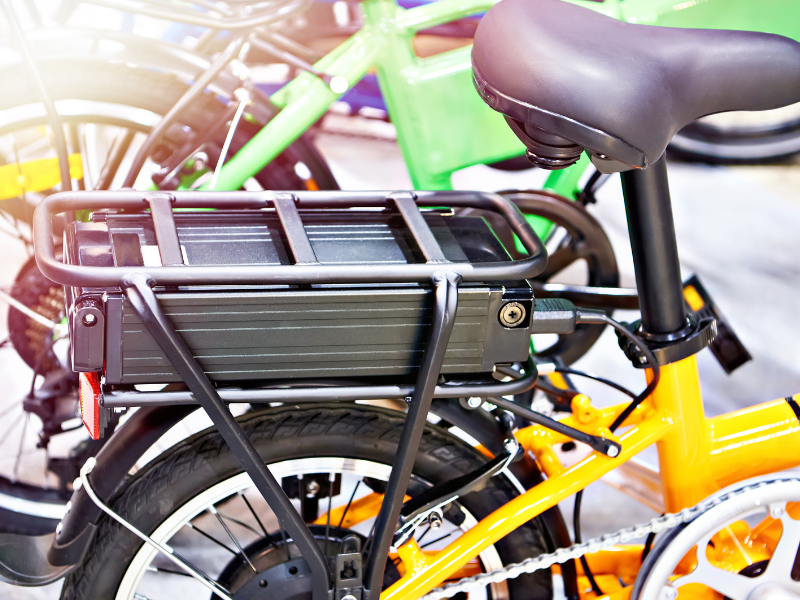
Exploring Different Types of E-Bike Batteries: Which One is Best for You?
🔋When choosing an e-bike, the battery is one of the most critical components to consider. The type of battery you select will affect your bike's range, weight, charging time, and overall performance. With several types of e-bike batteries available, it's essential to understand the pros and cons of each to determine which is best for your needs. In this article, we'll explore the different e-bike battery options and help you make an informed decision.
Lithium-Ion Batteries: The Gold Standard ⚡
Lithium-ion (Li-ion) batteries are the most common and widely used type of e-bike battery. They offer a high energy density, meaning they can store a lot of energy relative to their size and weight. This makes them ideal for e-bikes, where weight and space are critical factors. Li-ion batteries are known for their long lifespan, fast charging times, and relatively low maintenance requirements.
However, they tend to be more expensive than other battery types. Despite the cost, their performance and durability make them the best option for most e-bike riders.
- Pros: High energy density, lightweight, long lifespan, fast charging.
- Cons: Higher cost, sensitive to extreme temperatures.
Lithium Polymer (LiPo) Batteries: Lightweight and Compact 💡
Lithium Polymer (LiPo) batteries are a type of lithium-ion battery that uses a polymer electrolyte instead of a liquid one. This allows for a thinner, lighter, and more flexible battery design. LiPo batteries are known for their compact size and lightweight properties, making them ideal for e-bikes where space and weight are limited.
However, LiPo batteries are more expensive and can be less stable than other lithium-based batteries. They require careful handling and proper charging to ensure safety and longevity.
- Pros: Lightweight, compact, flexible design.
- Cons: Higher cost, requires careful handling and charging.
Nickel-Metal Hydride (NiMH) Batteries: An Older Option 🧩
Nickel-Metal Hydride (NiMH) batteries were popular before lithium-ion batteries became the standard for e-bikes. They offer a good energy density and are less expensive than lithium-based batteries. NiMH batteries are also more environmentally friendly than older nickel-cadmium (NiCd) batteries.
However, NiMH batteries are heavier, have a shorter lifespan, and take longer to charge than lithium-ion batteries. They also suffer from a higher self-discharge rate, meaning they lose charge more quickly when not in use.
- Pros: Lower cost, environmentally friendlier than NiCd.
- Cons: Heavier, shorter lifespan, longer charging times, higher self-discharge rate.
Lead-Acid Batteries: Budget-Friendly but Bulky 💰
Lead-acid batteries are one of the oldest types of rechargeable batteries and are still used in some e-bikes due to their low cost. They are durable and can provide reliable power, but they are also the heaviest and least energy-dense option available. This makes them less suitable for modern e-bikes where weight and size are significant considerations.
Lead-acid batteries also have a shorter lifespan and take longer to charge compared to lithium-ion batteries. They are best suited for budget-conscious buyers who don't mind the extra weight and bulk.
- Pros: Low cost, durable, widely available.
- Cons: Heavy, bulky, lower energy density, shorter lifespan, longer charging times.
Choosing the Best E-Bike Battery for Your Needs 🛠️
When selecting the best e-bike battery, consider the following factors:
- Range: If you plan on taking long rides, you'll need a battery with a high capacity, such as a lithium-ion battery. Consider the watt-hours (Wh) rating, which indicates the total energy capacity of the battery.
- Weight: For riders who prioritize a lightweight bike, lithium-ion or lithium-polymer batteries are the best choices due to their high energy density and lower weight.
- Cost: If you're on a budget, lead-acid or NiMH batteries may be more affordable options, but they come with trade-offs in terms of weight, lifespan, and performance.
- Charging Time: If you need a quick turnaround between rides, lithium-ion batteries offer the fastest charging times.
- Durability: Consider the battery's lifespan and how it will perform under different environmental conditions. Lithium-ion batteries generally offer the best balance of durability and performance.
Conclusion
Choosing the right e-bike battery is essential for getting the most out of your e-bike experience. While lithium-ion batteries are generally the best choice for most riders due to their balance of weight, performance, and durability, other options like lithium-polymer and lead-acid batteries may be suitable depending on your specific needs and budget.
Explore our range of e-bikes and battery options to find the perfect fit for your ride. Whether you prioritize range, weight, or cost, there's a battery out there that’s just right for you. 🔋

